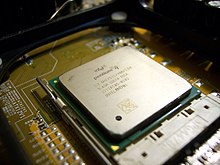
Back Pentium 4 Afrikaans بنتيوم 4 Arabic Pentium 4 Azerbaijani Працэсар Пэнтыюм 4 BE-X-OLD Pentium 4 Catalan Pentium 4 Czech Intel Pentium 4 German Intel Pentium 4 Greek Pentium 4 Esperanto Pentium 4 Spanish
 | |
| General information | |
|---|---|
| Launched | November 20, 2000 |
| Discontinued | December 7, 2007 (orders) [1] August 8, 2008 (shipments) [2] |
| Marketed by | Intel |
| Designed by | Intel |
| Common manufacturer |
|
| Performance | |
| Max. CPU clock rate | 1.3 GHz to 3.8 GHz |
| FSB speeds | 400 MT/s to 1066 MT/s |
| Cache | |
| L1 cache | 16 KB (8 KB data + 8 KB instructions) |
| L2 cache | Up to 2 MB |
| L3 cache | 2 MB (Gallatin only) |
| Architecture and classification | |
| Microarchitecture | NetBurst |
| Instruction set | x86 (i386), x86-64 (only some chips) |
| Instructions | MMX, SSE, SSE2, SSE3 (since Prescott) |
| Physical specifications | |
| Transistors |
|
| Sockets | |
| Products, models, variants | |
| Brand names |
|
| History | |
| Predecessor | Pentium III |
| Successors |
|
| Support status | |
| Unsupported | |
Pentium 4[3][4] is a series of single-core CPUs for desktops, laptops and entry-level servers manufactured by Intel. The processors were shipped from November 20, 2000 until August 8, 2008.[5][6] It was removed from the official price lists starting in 2010, being replaced by Pentium Dual-Core.
All Pentium 4 CPUs are based on the NetBurst microarchitecture. The Pentium 4 Willamette (180 nm) introduced SSE2, while the Prescott (90 nm) introduced SSE3 and later 64-bit technology. Later versions introduced Hyper-Threading Technology (HTT).
The first Pentium 4-branded processor to implement 64-bit was the Prescott (90 nm) (February 2004), but this feature was not enabled. Intel subsequently began selling 64-bit Pentium 4s using the "E0" revision of the Prescotts, being sold on the OEM market as the Pentium 4, model F. The E0 revision also adds eXecute Disable (XD) (Intel's name for the NX bit) to Intel 64. Intel's official launch of Intel 64 (under the name EM64T at that time) in mainstream desktop processors was the N0 stepping Prescott-2M.
Intel also marketed a version of their low-end Celeron processors based on the NetBurst microarchitecture (often referred to as Celeron 4), and a high-end derivative, Xeon, intended for multi-socket servers and workstations. In 2005, the Pentium 4 was complemented by the dual-core-brands Pentium D and Pentium Extreme Edition.
On December 7, 2007, Intel discontinued orders for the Pentium 4 processor. The last shipments were made on August 8, 2008, along with the Pentium D.[7]
- ^ "Product Change Notification, 107779 - 00" (PDF). Intel. 2007.
- ^ "Product Change Notification, 107779 - 00" (PDF). Intel. 2007.
- ^ Carmean, Doug (Spring 2002). "The Intel® Pentium® 4 Processor" (PDF).[self-published source?]
- ^ "X-bit labs - Print version". www.xbitlabs.com. Archived from the original on March 6, 2016. Retrieved January 11, 2022.
- ^ "Intel Introduces The Pentium 4 Processor". Intel. Archived from the original on April 3, 2007. Retrieved August 14, 2007.
- ^ "Intel intros 3.0 GHz quad-core Xeon, drops Pentiums". TG Daily. Archived from the original on May 17, 2019. Retrieved May 17, 2019.
- ^ "Product Change Notification, 107779 - 00" (PDF). Intel. 2007.